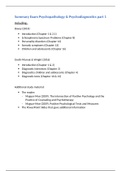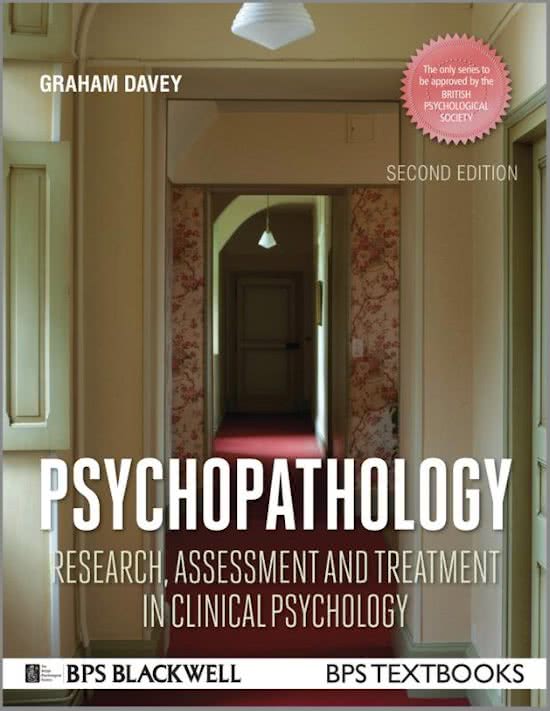Summary Exam Psychopathology & Psychodiagnostics part 1
Including:
Davey (2014):
Introduction (Chapter 1 & 2.1)
Schizophrenia Spectrum Problems (Chapter 8)
Personality disorders (Chapter 12)
Somatic symptoms (Chapter 13)
Children and adolescents (Chapter 16)
Groth-Marnat & Wright (2016)
Introduction (Chapter 1 & 2)
Diagnostic interviews (Chapter 3)
Diagnostics children and adolescents (Chapter 4)
Diagnostic tests (Chapter 10 & 13)
Additional study material:
The reader:
- Magyar-Moe (2009). The Intersection of Positive Psychology and the
Practice of Counseling and Psychotherapy
- Magyar-Moe (2009). Positive Psychological Tests and Measures
The PowerPoint Slides that gave additional information
,1.1 Introduction (Davey chapter 1 & 2.1)
Historical explanations of psychopathology such as ‘demonic possession’ often alluded to the
fact that the individual had been ‘possessed’ in some way.
Many ancient civilizations believed that those exhibiting symptoms of psychopathology were
possessed by bad spirits: demonology.
The medical model attempts to explain psychopathology in terms of underlying biological or
medical causes.
Historically individuals with mental health problems were often locked away in asylums or
given lifelong custodial care in psychiatric hospitals.
Asylums: In previous centuries asylums where hospices converted for the confinement of individuals
with mental health problems.
Current models of mental health espouse compassion, support, understanding, and
empowerment.
Potential ways of defining psychopathology include deviation from the statistical norm,
deviation from social/political norms, exhibiting maladaptive behaviour or harmful
disfunction, and experiencing distress and impairment.
Psychopathology is a social agreement guided by science. And it is the study of deviations from
normal or everyday psychological or behavioural functioning.
Psychological models view psychopathology as cause primarily by psychological rather than
biological causes.
Influential psychological models of psychopathology include biological models, the
psychoanalytic model, the behavioural model, the cognitive model, and the humanist-
existential model.
Biological models attempt to explain psychopathology in terms of processes such as genetics and
brain structure and function.
Psychoanalytical models attempt to discuss psychopathology in terms of the psychological
mechanisms that help to defend against anxiety and depression.
Behavioural models use processes of learning such as classical conditioning and operant conditioning
to understand how psychopathology might be acquired.
The cognitive model considers psychopathology to be the result of individuals acquiring irrational
beliefs, developing dysfunctional ways of thinking, and processing information in biased ways.
The humanist-existential approach attempts to help the individual gain insight into their lives from a
broad range of perspectives and develop a sense of meaning in life.
Social stigma is characterized by prejudicial attitudes and discriminating behaviour directed
towards individuals with mental health problems.
Stigmatising beliefs about people with mental health are held by a broad range of individuals
within society, including family members, peers, teachers, and members of the medical
profession.
The popular media often play a role in perpetuating stigmatising stereotypes of people with
mental health problems.
Stigma had a detrimental effect on treatment outcome for people with mental health
problems.
, Stigma can be addressed by adopting methods described in the social psychology literature
for improving intergroup relations.
The two most influential classification systems are the American Psychiatric Association
(APA) Diagnostic and Statistical Manual and the World Health Organisation (WHO)
International List of Causes of Death (ICD).
Why classify?
- To research causes and development
- To structure mental healthcare
- To examine effectiveness of treatments
- Society considers it necessary to classify and group people
Currently, the most widely adopted classification system is the DSM-5.
The DSM is based on a medical model: attributes abnormal behaviour to physiological, biochemical
or genetic causes.
Advantages: Disadvantages:
- Worldwide uniformity - Classification is based on symptoms rather than causation
- Improved communication - Stigma through labelling
- Reliable, quantifiable - Danger of inappropriate use
- Recognisability of categories - Over-simplification
- Theory neutral - Restricted diagnoses
- Limits comorbidity - Limits comorbidity
- Greater insight treatment outcomes - Many changes in the DSM: what is considered an illness?
- Labels can offer assurance - Limited association between diagnoses and treatment
1.2 Introduction (Groth-Marnat & Wright chapter 1 & 2)
Know the central role of the clinician and how to fulfil this role
The central role of clinicians conducting assessment should be to answer specific questions and make
clear, specific, and reasonable recommendations to help improve functioning/ The central role of the
clinician performing psychological assessment is that of an expert in human behaviour who must deal
with complex processes and understand test-scores in the context of a person’s life.
To fulfil this role, clinicians must integrate a wide range of data and bring into focus diverse areas of
knowledge. Clinicians should be not only knowledgeable about traditional content areas in
psychology and the various contexts of assessment but also able to integrate the test data into a
relevant description of the person.
In addition to an awareness of the role suggested by psychological assessment, clinicians should be
familiar with core knowledge related to measurement and clinical practice. This includes descriptive
statistics, reliability (and measurement error), validity (and the meaning of test scores), normative
interpretation, selection of appropriate tests, administration procedures, variables related to
diversity (ethnicity, race, gender, culture), testing individuals with disabilities and an appropriate
amount of supervised experience. Clinicians should also know the main interpretive hypotheses in
psychological testing and be able to identify, sift through and evaluate a series of hypotheses to
determine which are most relevant and accurate.
Know and explain the five important points in evaluating psychological tests (see Table 1.1)
Understand the differences between test-retest reliability, alternate forms, internal
consistency and interscorer reliability
, Understand how a low reliability affects the interpretations and predictions based on the test
data
Understand the differences between content validity, criterion validity, and construct validity
(convergent and discriminant validity)
1. Theoretical orientation: Clinicians should research the construct that the test is supposed to
measure and then examine how the test approaches this construct.
2. Practical considerations: First, tests vary in terms of the level of education (reading skill) that
examinees must have to understand them adequately. Second, some tests are too long, which can
lead to a loss of rapport with or extensive frustration on the part of the examinee. Finally, clinicians
have to assess the extent to which they need training to administer and interpret the instrument.
3. Standardization: This relates to the adequacy of norms. First: whether the standardization group
includes representation from the population on which the examiner would like to use the test.
Second: whether the standardization group is large enough. Third: a test may have specialized
subgroup norms as well as broad national norms. Standardization can also refer to administration
procedures. A well-constructed test should have clear instructions that permit examiners to give the
test in a manner similar to that of other examiners.
4. Reliability: The reliability of a test refers to its degree of stability, consistency and predictability.
A high measure of reliability is usually generally .80 or more, but the variable being measures also
changes the expected strength of the statistic. Ideally, clinicians hope for reliability statistics of .90 or
higher in tests. The purpose of reliability is to estimate the degree of test variance causes by error.
There are four primary methods of obtaining reliability.
- Test-re-test: the extent to which the test produces consistent results upon retesting.
- Alternate forms: the relative accuracy of a test at a given time. (e.g. parallel test)
- Split-half/coefficient alpha: the internal consistency of the items.
- Inter-scorer: the degree of agreement between two examiners.
5. Validity: Validity assesses whether a test truly measures the trait that it is supposed to measure.
Content validity: refers to the relevance of the assessment instrument to the construct being
measured.
Criterion validity: Comparing test scores with some sort of performance on an outside measure.
Consists of predictive validity and concurrent validity.
Construct validity: Refers to measuring the construct you want to measure.
A component to build construct validity is to estimate the degree of internal consistency by
correlating specific subtests with the test’s total score. A final method for obtaining construct validity
is to converge/correlate highly with variables that are theoretically similar to it. The test should not
only show this convergent validity but also have discriminant validity in which it would demonstrate
low correlations with variables that are dissimilar to it.
Understand how the inadequacy to take into account base rate, the confirmatory bias and
the hindsight bias influence clinical judgement.
A possible source of inaccuracy is that clinicians do not take into account the base rate or the rate at
which a particular behaviour, trait or diagnosis occurs in the general population.
- Confirmatory bias: information obtained earlier in the data collection process is frequently given
more importance than information received later (primary effect).
- Hindsight bias: persons were generally overconfident regarding judgments and when outcome
knowledge was made available, clinicians typically overestimated what they thought they knew
before receiving outcome knowledge.
Know and explain the eight phases in clinical assessment (see Figure 1.1)





